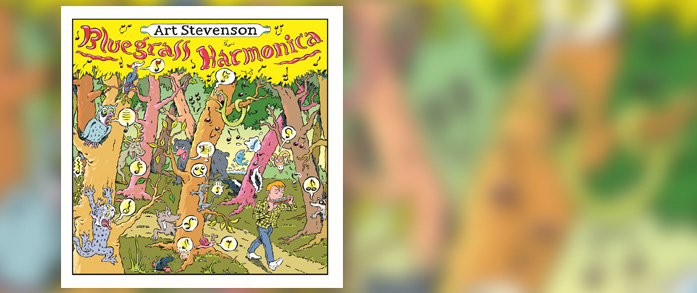Although harmonica is far more closely associated with blues than it is to bluegrass, Art Stevenson proves it can provide a perfect fit regardless. Although he’s also made his mark as a guitarist, vocalist, producer, and bandleader for the past 30 years, he continues to instill the sound of harmonica within bluegrass realms, whether it’s in a selective role or with more prominent positioning.
His new album on White Oak Records, Bluegrass Harmonica, could be considered a compilation of sorts, one that contains songs that have been performed live, tracks that have been previously recorded, and others that represent a sampling of new, heretofore unreleased material. Despite the disparate origins, it holds together remarkably well, given the fact it wholly delves into traditional tunes and the occasional standard as gleaned from the pens of Bill Monroe, Fred Rose, and Jimmie Rogers. So too, with Stevenson’s harp setting up the tome and tempo, it conveys a joyful and jaunty feel overall, from the strut and stride of Sail Away Ladies, Gold Rush, and Married Life Blues, to the homespun hoedown feel typifying Pick A Bale Of Cotton, the swing and sashay of Handsome Molly, and the steady shuffle that drives Sally Goodwin, and Bringing in the Georgia Mail.
Stevenson’s collaborators — Audie Blaylock (mandolin), wife Stephanie Stevenson (bass, vocals), Bruce B. King (mandolin), Chris Silver (lead guitar, mandolin), Gary Barite (mandolin), Lonnie Bowden (jaw harp, banjo, vocals), Tom Boyarski (lead guitar), Sam Pankratz (guitar), Oscar Noetzel (banjo), and Dale Reichert (banjo, dobro) — each add an essential element, particularly Reichert, whose precise picking seems to soar on any number of these instrumental excursions — Girl I Left Behind and Black Mountain Rag in particular. Nevertheless, Stevenson still manages to take center stage, his harp filling out the role normally given to a fiddler’s finesse. Likewise, his yodel on When It’s Peach Picking Time In Georgia affirms the comfort and caress that beloved song traditionally calls for.
Likewise, even the most familiar fare — Orange Blossom Special, Old Joe Clark, Blue Eyes Crying In the Rain among them — is imbued with an invigorating energy that transforms what may seem old into something that definitely feels new again. That’s because Bluegrass Harmonica, its unassuming title aside, is dominated almost entirely by a giddy, good time feel accelerated by a feeling of unmistakable, unabashed enthusiasm.
An astute expression of skill and celebration in equal measure, Bluegrass Harmonica finds Stevenson tapping tradition and neatly fitting it into contemporary confines. There’s certainly nothing that’s more satisfying than that.
